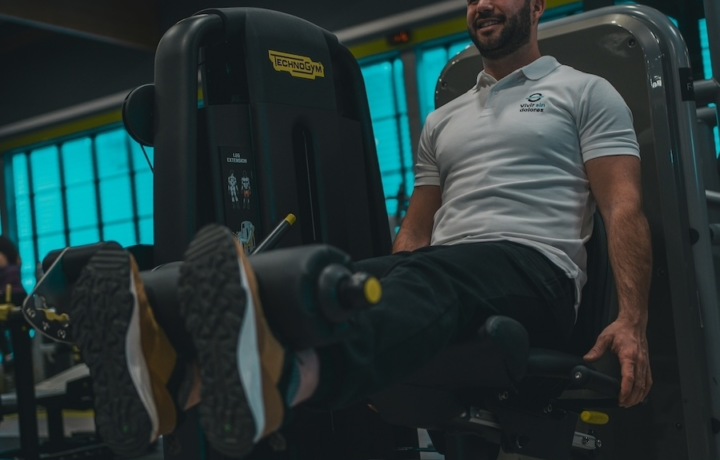Exercise
Jump Box

Jump Box
How to Perform
- Stand in front of the box with your feet hip-width apart and arms by your sides, ensuring your body is upright with a neutral spine position.
- Shift your weight slightly onto the balls of your feet and bend at the knees and hips to lower into a quarter squat position while swinging your arms behind you.
- Explosively extend your hips, knees, and ankles while simultaneously swinging your arms forward and upward to propel yourself onto the box.
- Take off from both feet simultaneously, exhaling during the explosive phase of the movement.
- Land softly with both feet completely on the box surface, absorbing the impact by slightly bending your knees and hips.
- Stand fully upright on the box by extending your hips and knees, keeping your chest up and shoulders back.
- Step down one foot at a time or jump down with both feet landing softly with bent knees, depending on your fitness level and box height.
- Inhale as you reset your position, ensuring your feet return to hip-width apart before attempting your next repetition.
Important information
- Choose an appropriate box height based on your fitness level – start lower and progress as your confidence and strength improve.
- Keep your gaze focused on the center of the box throughout the entire movement to maintain proper landing position.
- Ensure the box is stable and on a non-slip surface to prevent accidents or injuries.
- If you're new to box jumps, practice with step-ups or smaller jumps before attempting full height jumps.

Jump Box
Exercise Details
Primary Muscles
Muscle Groups
Mechanic
Risk Areas
Built for progress
Take the guesswork out of training
Create personalized AI-powered workout plans that evolve with you. Train smarter, track every rep and keep moving forward, one workout at a time.






The jump box is an incredibly versatile training tool that has revolutionized functional fitness across HIIT and CrossFit communities. This simple yet effective piece of equipment offers intermediate athletes a challenging way to develop explosive power through the lower body, primarily targeting the quads, glutes, and calves in one dynamic movement.
What makes the jump box particularly valuable is its ability to simultaneously build strength, endurance, and cardiovascular capacity. The height challenge creates progressive overload opportunities that few other exercises can match, allowing athletes to quantifiably track improvements in their explosive power over time.
During high-intensity interval training sessions, the jump box serves as a perfect station for maximal effort bursts that elevate heart rate rapidly while building muscular endurance in the lower kinetic chain. CrossFit athletes particularly value jump box work for developing the explosive hip extension pattern critical for Olympic lifting and other compound movements.
The beauty of jump box training lies in its scalability. The same box that challenges a beginner can be repositioned to test even advanced athletes, making it a staple in functional fitness programming. The neurological demands of box jumping also improve proprioception and spatial awareness, contributing to better overall athletic performance.
Beyond physical benefits, jump box work develops mental fortitude as athletes must commit fully to each repetition, building confidence that transfers to other athletic endeavors. This psychological component makes it particularly effective for breaking through plateaus in training.
As with any plyometric movement, jump box work creates significant training stimulus with relatively low repetitions, making it an efficient addition to any workout program that values time-efficient results. The combination of strength development, cardiovascular challenge, and coordination requirements makes the jump box a cornerstone tool for those serious about functional fitness and athletic development.
FAQ - Jump Box
Jump box primarily targets the quadriceps, glutes, and calves while also engaging your core and hamstrings. The explosive movement pattern develops power through the entire posterior chain, making it an excellent compound exercise for lower body development.
Beginners should start with a lower box height (12-18 inches) and focus on precision landings rather than height. As you progress, increase box height incrementally, add weighted vests, or incorporate more complex variations like lateral jumps or depth jumps to continue challenging your explosive power.
The most critical error is selecting a box that's too tall, which compromises form and increases injury risk. Other common mistakes include landing with straight legs, not using your arms to assist momentum, and failing to step down carefully between repetitions rather than jumping down, which places unnecessary stress on your joints.
For optimal results without overtraining, include jump box exercises 2-3 times weekly with at least 48 hours between sessions to allow for muscle recovery. Start with 3-4 sets of 5-8 repetitions, focusing on quality over quantity, as plyometric movements create significant training stimulus even at lower repetition ranges.
Jump box exercises create significant impact forces and are generally not recommended for those with existing knee injuries or severe joint issues. If you have minor knee concerns, consider step-ups as a lower-impact alternative that still builds strength, or consult with a physical therapist who can assess your specific condition and provide appropriate modifications.









